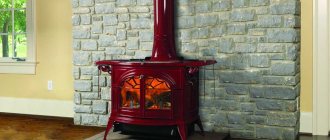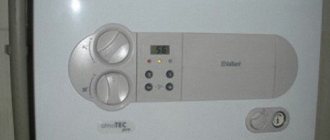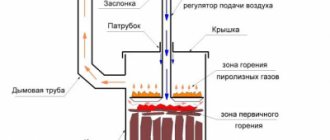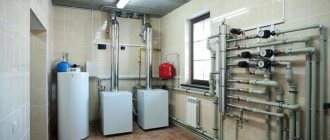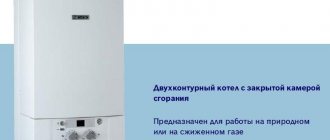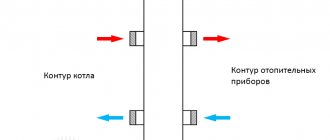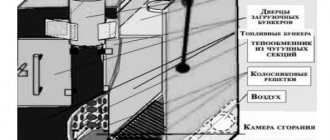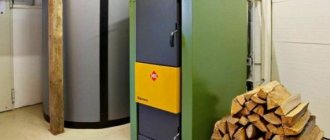Heating cost calculation
The cost of repairing heating systems
Cost of installation of water supply
Heating of country houses and dachas (in the absence of gas and electric networks) is solved in a fairly simple and effective way. We are talking about heating devices such as solid fuel boilers , which use fuel in the form of coal or brown coal, firewood or similar combustible materials.
Operating principle of a long-burning boiler
Solid fuel boilers appeared relatively long ago, but all of them, regardless of model and manufacturer, had one significant drawback.
Fuel had to be constantly added as it burned. It was ineffective and not economical. This situation continued exactly until 2000, until the Stropuva company found a way to eliminate this problem. It is to engineer Edmuntas Štropaitis that we owe the invention of the long-burning boiler. Today, this is the most practical and functional device for heating a private home or cottage, the performance level of which reaches 70 and sometimes 100%. But, unlike classic pyrolysis boilers, which are also characterized by good efficiency, such units can maintain heat for 7 days with just one batch of fuel!
What are its main technical features and what makes this device so economical and effective?
Long-burning boiler design
The operating principle of a long-burning solid fuel boiler is similar to pyrolysis units. The main heat is generated not from the combustion of wood or coal, but from the gasification of solid fuel. The combustion process takes place in a closed space, from where wood gas is released through a special telescopic pipe.
After this, the gas is directed into the heater nozzle, where diffusion (mixing) occurs with secondary air pumped by the fan. Thus, a continuous process will occur until the coals or firewood are completely burned. In this case, the combustion temperature sometimes reaches 1200 degrees.
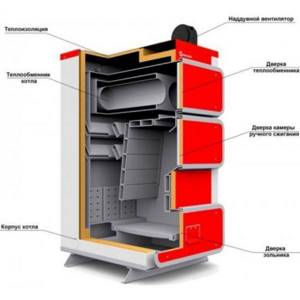
Internal structure of a long-burning boiler
The effectiveness of this principle lies precisely in the fact that solid fuel is consumed very slowly, as needed, which significantly increases the efficiency of such a heating device. But not only high performance is the advantage of this design.
As a rule, the whole point of long-lasting combustion is that not the entire load of coal or firewood burns out at the same time, but only the top layer. Due to the fact that air is supplied from above and not from below, fuel burnout occurs gradually, in its upper layer.
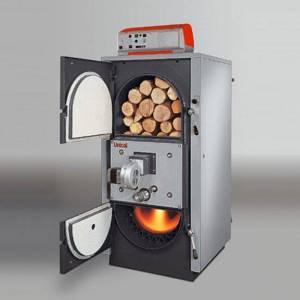
Long burning principle
When this layer burns out, the air supply is turned on, and exactly as much as is needed to burn the top layer. This ensures such a burning duration and the ability to control the process.
It should be said that this version of the heating device is acceptable exclusively as a heating system. If you need to think about a water heating system for domestic needs, then you should look for other options.
If the option is selected specifically for heating a large house, then such a device is an excellent alternative to electric and gas appliances.
Popular models of coal boilers
The top five popular lines include 3 budget variations costing up to 75 thousand rubles and 2 representatives of the middle price segment.
Protherm Beaver 50 DLO
An impressive cast-iron unit made in Slovakia costs about 70 thousand rubles; it exhibits minimal heat loss thanks to insulation made of inorganic insulation. The combustion chamber has an unusual shape of bends, which significantly increases its usable area. The equipment is designed to service houses up to 350 square meters. meters. The boiler is easy to operate; there is an air regulator in its upper part.
The model has a single-circuit floor design; it does not support hot water supply. The power of the device will decrease if you replace coal with firewood.
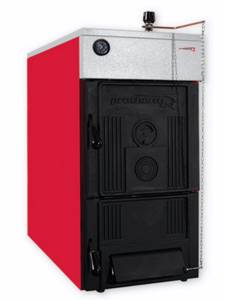
Heating boiler Protherm Beaver 50 DLO
Danko 20 TN
With a price tag of 40 thousand rubles, it is difficult to expect high efficiency, but there are also advantages - the ability to load once every 8 hours. The model is intended for heating rooms with an area of no more than 180 square meters. meters, does not require labor-intensive maintenance. The priority fuel is coal; if available, anthracite can also be used. Pleasant design, affordable cost, cost-effectiveness of resource consumption are the main advantages.
With its own weight of 180 kg, up to 90 liters of water are placed in the boiler, the chimney height is 5 m, the volume of a one-time fuel load is 55 kg.
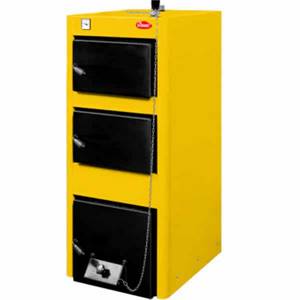
Boiler Danko 20 TN
Dakon DOR F 16
A fairly affordable price - 65 thousand rubles - and an interesting design were the main reasons for the relevance of this series. The model is very demanding in terms of space and quality of installation and has restrictions regarding the use of firewood. Nevertheless, the boiler copes well even with raw coal; low-grade fuel will not affect its level of functionality and efficiency. Average efficiency for this segment, energy independence, low dead weight (166 kg) make the unit indispensable in northern latitudes.
The Czech model is designed for heating compact buildings with 2-3 rooms; it is equipped with a mechanism for shaking the coal and protection against overheating. The only drawback may be capriciousness regarding energy resources - the equipment uses coal rationally, but works unproductively with other solid types of fuel.
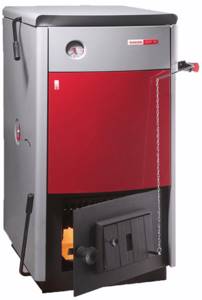
Solid fuel boiler Dakon DOR F 16
Emtas BioTerm EK3G/S-40
The boiler, which costs 176 thousand rubles, can also be used to burn chip briquettes; the raw materials are loaded into a large bunker. With a thermal output of 46 kW, the model exhibits an efficiency of 88%. The unit is designed to serve spacious houses - it successfully heats 250-500 square meters. meters. The device heats 80 liters of coolant, the firebox volume is 100 liters.
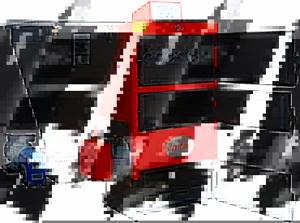
Heating boiler Emtas Bio Term EK3G/S-40
Wirbel EKO EL 30/18
The Austrian development impresses with its versatility: in addition to coal, it processes liquid fuel and can operate on electricity. The price tag is quite modest: for 84 thousand rubles you can purchase a unit additionally equipped with a heating element and a diesel burner.
Thermal power is kept at 30 kW, depending on the energy carrier used, the efficiency can reach 80-90%. The model is installed in houses with an area of no more than 300 square meters. meters, the provided volume of coolant corresponds to the productivity of 60 liters.
In the specialized market, devices that have built-in automation tools that allow you to remotely regulate power are gaining popularity. As a rule, these are powerful samples capable of serving 400-700 sq. meters, their coolant volume exceeds 120 liters.
Categories
- Hot water boilers
- Steam boilers
- Fireboxes
- Battery cyclones
- Modular boiler rooms
- Cyclones
- Accessories
- Smoke exhausters
- No category
- Grate bars
- Fuel supply
- Ash catchers
- Boiler automation
- Boiler pipes
- Smoke pipes
- Water treatment
- Thrower
- Electrodes
- Steam boiler rooms
- Reservoirs
- Skip hoists
What are modern boilers equipped with?
Most models of domestic and foreign manufacturers are equipped with thermal insulation, which helps reduce heat loss. In such boilers, a control unit equipped with a fan often replaces an automatic draft regulator.
To adjust the combustion intensity, you can select an automatic or manual air supply regulator to the combustion chamber. Low-power boilers with manual adjustment are convenient to use because they allow you to adjust the draft in accordance with the selected temperature regime.
Double-circuit solid fuel boilers are also in great demand, performing two functions simultaneously: heating the premises of the house and providing its residents with hot water. When choosing a device, it is worth determining for yourself whether it will be the main or auxiliary element of the system.
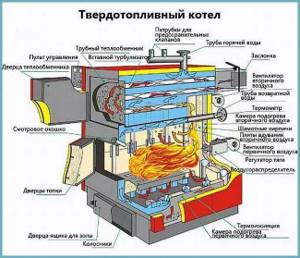
Scheme: operation of a solid fuel boiler
If you focus on the cost of a solid fuel boiler, then it is better to give preference to units from foreign manufacturers in the middle price segment. The only significant difference from expensive analogues will be the absence of complex electronics.
Its main task is to control the combustion process taking into account the temperature of the interior and exterior air, thereby simplifying the operation of the unit.
What to look for when choosing coal
There are many subtleties that relate to specific boiler models. For example, it is not recommended to constantly use long-flame brands “large nut” and “small nut” in ZEUS-TURBO boilers. This can lead to small fractions blocking the access of air through the grate, and large fractions to hang in the loading chamber.
The range of boilers is too large to describe the design features of each of them. Therefore, we will not touch on this issue, but will tell you what is important to consider when choosing coal. However, we strongly recommend that you carefully study the instructions specifically for your boiler before purchasing fuel.
Let us highlight the main indicators that need to be taken into account when choosing coal:
- Heat of combustion
- Ash content
- Humidity
Rating of combined boilers
A large number of different models sometimes causes difficulty in choosing even for specialists, not to mention ordinary buyers, so we publish the top 5 models. For clarity, let's summarize the data in a table.
Table 1. The best models of 2018-2019
| Model | Fuel types | Description | power, kWt | Efficiency,% | Weight, kg |
| ZOTA MIX-20 | Coal, firewood, gas, diesel fuel electricity | A model from a Russian manufacturer that consumes basic types of fuel without problems. Withstands short-term pressure increases up to 4 atm (working 3 atm). The material of the heating elements is a seamless stainless steel tube. Their operation is controlled by an external control panel. The device is also equipped with a draft regulator and a thermomanometer, which increases the efficiency of the combustion process. To protect against heat loss, the water jacket is insulated. Wear resistance of the outer casing is achieved thanks to powder paint coating. | 3-9 | 80 | 140 |
| KARAKAN 16TPEV 3 | Firewood, gas, electricity | The dual-circuit model of the Russian manufacturer is especially popular among rural residents, because It is equipped with a wide hob on which you can cook food for yourself and your livestock. The unit can easily heat an area of up to 160 sq.m., this applies not only to residential, but also to industrial premises, incl. greenhouse or garage. The depth of the steel firebox is 0.56 m. The “water jacket” prevents the metal from overheating or burning out, which makes the device’s service life long. | 9 | 75 | 120 |
| Teplodar Cupper PRO 22 | Firewood, coal, gas, pellets | The domestic model can easily heat rooms up to 220 sq.m. When using firewood or coal, the unit acquires the features of a long-burning boiler, since on one tab the operating period is 8 and 10 hours, respectively. Another plus is the spacious firebox, which can accommodate firewood up to 600 mm long. | 6 | 80 | 115 |
| Kiturami KRM 30R | Firewood, briquettes, coal, diesel. | The double-circuit boiler from South Korea is equipped with several combustion chambers and electronic control. Capable of heating a room up to 350 sq.m. The heat exchangers are made of alloy steel, so you should not increase the pressure too much. | 35 | 85-92 | 170 |
| Protherm Bison 40 NL | Gas, diesel, fuel oil | The double-circuit model from Slovakia is capable of heating areas up to 400 sq.m. The control is carried out using a microprocessor, and the electronic display clearly shows the operating parameters of the boiler at any given time. | 38 | 89 | 148 |
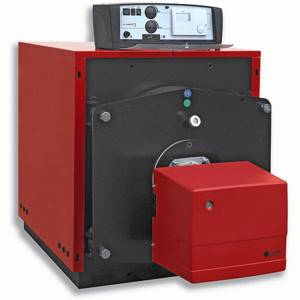
Appearance of the Protherm Bizon 40 NL boiler
Operating principle of the equipment
The working process is based on the combustion of fuel in the corresponding chamber
It is important to note that different materials can be used as fuel. For example, for a combination boiler, wood and coal are not the only energy sources
Such models can accept briquettes, pellets, husks and shavings. But for this it is necessary that the design of the chamber be oriented towards working with other types of solid fuel.
Regardless of the type of raw material consumed, the firebox releases thermal energy, which can be directly converted into hot air flows, or go into a heat exchanger to heat water. If a coal-fired boiler is used, the combustion process will be long and the thermal energy potential will be high. In contrast, low-density dry firewood or briquettes with chips burn quickly, leaving little heat but a lot of ash and ash.
Automatic fuel supply methods
Based on the methods of fuel supply, units with a pneumatic conveyor and a screw transmission are distinguished.
The choice of design depends on:
- noise level during operation of the heating installation;
- power consumption;
- frequency of fuel delivery to the combustion chamber and other indicators.
Pneumatic conveyor
Combustible materials are delivered to the main chamber of the boiler using air, which is pumped under pressure. The advantage of such models is that fuel is supplied less frequently. As a result, the system will be able to operate without electricity for a longer time. However, the pneumatic conveyor makes more noise during operation and consumes a lot of electricity - about 1.5–2 kW/hour.

Screw transmission
This method is used in most household units and is considered the most reliable, but it is not ideal.
Feeding is carried out via a screw conveyor, which operates almost silently and consumes less electricity - about 80 W/hour. The feed speed is adjusted automatically.
The use of an auger guarantees the flow of fuel into the boiler, but if its length is more than 2 m, flammable materials are ground into dust.
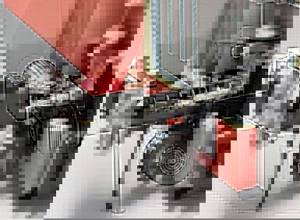
Automatic boilers
Long-burning automatic coal boilers offered on the modern market are designed on the principle of pellet installations. Their feature is the presence of a burner device and a bunker for loading fuel reserves. The design of the heat exchange part of the units repeats the design of their traditional “brothers”; a fire tube heat exchanger or other multi-pass design is used to transfer heat.
The main feature is the retort type burner. It consists of a bowl - a retort, a feed auger with a gearbox and an electric motor, and a fan for forcing air. Coal from the hopper will fall into the receiving hole of the feed auger, which moves it into the bowl. The latter has side slots for the flow of air pumped by the fan.
Such a coal-fired boiler is fully automated, from the electric ignition operation to the control of combustion intensity. The operating time of the unit is not limited by the fuel supply, which can be replenished by pouring it into the bunker on the move. Only the frequency of maintenance and cleaning requires stopping the boiler once a week.
A prominent representative of this type of heater is an automatic coal boiler of the Heiztechnik brand, equipped, in addition to the main components, with a circuit for supplying hot water, a circulation pump and a programmable controller with the ability to connect external thermostats. The controller controls the operation of the burner and can stop it at any time, which is a significant advantage for solid fuel units. Another plus is the ability to quickly install a grate, remove the burner and continue working with traditional direct combustion of fuel in the firebox. The efficiency of the unit is declared by the manufacturer at 88%.
The disadvantages of a coal boiler with a screw burner are its high cost and demands on the quality of fuel. The Heiztechnik manufacturer's requirements are as follows:
- fraction size – no higher than 25 mm;
- humidity – up to 10%;
- dust content in fuel – no more than 20%;
- coal for automatic boilers - medium-coking, type 31 or 32, not higher.
Improvements for increased efficiency and durability
There are still many technological solutions that increase the service life of boilers and/or their efficiency:
- Cooling circuit. This element is installed in direct combustion units. Due to the inability to control the intensity of fuel combustion, the water in the system may boil. To prevent such cases, a two-way valve is installed in the hot water supply line, and a separate cooling loop is provided in the system. When the critical temperature is reached (usually set to 95°C), the valve connects a cold water loop to the system, and the temperature of the coolant drops.
- Cooled grates. Burnt out grates in coal boilers are a problem that has been quite difficult to deal with. Steel ones failed very quickly, cast iron ones lasted a little longer, but still their service life was short. To make it easy to replace a burnt-out part, they were made removable. The situation became much better when they came up with the idea of making hollow grates from pipes through which water circulates. In this case, they are made non-removable. Thus, the grate bars last longer, and the heat is used to heat the room.
- Movable grate bars. This interesting improvement solves the problem of coal caking. Usually, in order to break the slag cake, you need to open the firebox and vigorously poke around with a poker. Boilers with movable grates have a handle that, when pressed, crushes the slag.
- Artificial injection of air into the firebox. Either heat-resistant fans or more powerful turbines are installed. This improvement leads to two results at once: firstly, coal burns better, and secondly, the requirements for chimney draft and height become lower. Fans create active air movement, and combustion products, even with not very good natural draft, are well removed. But there is also a minus - such a system only works if there is a power supply. In this case, it is already possible to electronically regulate the combustion intensity by changing the fan rotation speed.
There is one more nuance that is worth considering when choosing a coal boiler for heating a private home. The power, which is indicated in the technical data, is calculated for the most high-calorie type of coal that can be burned in this unit: coke or anthracite. When using coal, which has a lower calorie content, you will not be able to achieve such an amount of heat. Therefore, when choosing a coal boiler, take the power with a margin of 15-20%. Then you won’t have to freeze even in the most severe frosts.
Coal-fired heating boilers are one of the most popular types of heating equipment
The popularity of solid fuel units is explained by their low price, not very expensive, and sometimes free, fuel. In addition, coal heating boilers are, in principle, omnivorous: they can be heated with any kind of coal, not just hard coal. They feel fine when loaded with peat, firewood, and briquettes. It’s just that less heat will be generated and you’ll need to add it more often.
For complete comfort, one or more heating elements are built into coal boilers. Such boilers are called combined boilers, and the electrical part is turned on after the fuel has burned out and the coolant temperature drops below a certain point. Such equipment allows you to leave the house unattended for a while and not be afraid that the system will defrost. Moreover, they cost a little more than regular ones, but they significantly increase the comfort of use.
In general, the heating equipment market is constantly evolving, new ideas and improvements are being introduced that increase the efficiency, environmental friendliness and level of heating comfort. And these are not all of today’s technological innovations, but the most popular and significant ones.
Advantages of boilers of this type
As mentioned above, a modern coal-fired boiler has much in common with a classic Russian stove. But if a hot brick fireplace directly heats the air in the house, a coal boiler heats water, which then circulates through the radiator system of the heated room.
In all other respects, solid fuel boilers for heating a private house embodied the versatility of their original Russian predecessor. For example, they are unpretentious in the choice of combustible material and allow you to charge firewood, briquettes, pellets, sawdust, paper waste, rags, which in itself is a good idea for recycling combustible waste.
On the other hand, of course, operating a boiler using “frozen” fuel requires more control: you will have to monitor instrument readings and replenish the tank more often. And since such raw materials burn unevenly, temperature changes are possible in the radiator system. Not to mention the fact that garbage that is not used as fuel leaves carbon deposits and soot that need to be cleaned.
Therefore, despite the abundance of waste fuel, prudent (read lazy) owners acquire a large supply of long-burning coal. Using such a heat source, the stove can operate for several days without requiring additional maintenance, cleaning or even refueling.
Unlike a Russian stove, which requires compliance with a certain kindling technology, a coal boiler is extremely easy to use - just open the firebox and throw coal inside
This operation requires a minimum of precautions; the installation and operation features of a coal boiler mean that all potentially dangerous processes are controlled automatically
Another advantage of a coal boiler is its high efficiency, and the use of modern energy-saving technologies has doubled the productivity of new solid fuel boilers compared to old-style coal stoves.
Of course, for a city dweller, spoiled by centralized heating and water supply, the need to load the tank from time to time may seem tedious, but only at first glance. Almost all modern coal-fired boilers make the most of a single load, and temperature control is carried out by sensor systems and air supply devices.
Due to their high efficiency and safety, coal fuel boilers are successfully used for heating cottages and summer houses, residential buildings and offices. But, of course, coal equipment finds ideal use in private residential construction, where its surface can also be used to heat food.
Advantages and disadvantages of equipment
Using a boiler for heating with coal in a private house is accompanied by several positive aspects:
- ease of maintenance;
- high efficiency;
- uninterrupted operation throughout the full season;
- possibility of combination with wood raw materials;
- process automation;
- provided smoldering operating mode;
- efficiency.
Weaknesses of the equipment:
- the boiler room must be ventilated - this is a mandatory condition for fire safety;
- the need to arrange a technically complex chimney;
- you need to equip a dry place for storing coal.
The heating system usually operates together with a smoke exhauster and a fan; these are quite energy-intensive mechanisms.
Criteria for selecting long-burning solid fuel boilers
We have already become familiar with the general classification of solid fuel boilers. It's time to consider the criteria by which owners of private houses determine the optimal options for units for installing heating systems. After reading the following sections, you will learn how to choose the right long-burning solid fuel boiler for your home.
Type of fuel
First of all, you must decide what fuel will be used for heating. Based on what type of fuel is more convenient to buy and import. If you have harvested wood, it would be wise to purchase a wood-burning boiler. Owners of cottages where there are no trees can recommend heating with pellets. Coal boilers are suitable for those who have the opportunity to order high-quality fuel on favorable terms. Sawdust heating systems are typically used to heat wood processing facilities.
Boiler power
To determine the required power of the heating system, you need to make simple mathematical calculations. Calculate the total volume of the premises you are going to heat. The resulting figure will help you find a model with the appropriate parameters in a wide range of long-burning solid fuel boilers. Keep in mind: you should always provide a power reserve so that during severe winter frosts the house does not become cold.
Device weight
When choosing a long-burning solid fuel boiler for heating a private home, the mass parameter is taken into account only if the owner intends to mount the purchased unit on the wall. According to state standards established by the Russian gas service, this installation method is allowed for heating boilers with a volume of less than 100 liters
Loading chamber volume
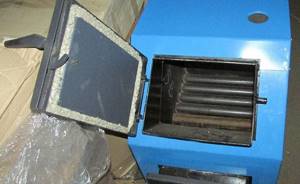
This parameter characterizes the ratio of the volume of fuel supplied to the power of the heating unit. The more fuel that fits in the loading chamber, the less often you will have to replenish the supply of firewood/coal/pellets. For steel boilers, the ratio of these values is 1.6-2.6 l/kW. Cast iron heating units consume fuel in smaller quantities - 1.1-1.4 l/kW.
The total volume of the loading chamber will help you roughly estimate the capabilities of the boiler. In any case, you will not be able to fill it 100%. The usable volume of the loading chamber is much more important. This value reflects the actual amount of fuel that you can load into the combustion chamber. To determine it, you need to know the principle of combustion of the selected boiler and the method of loading fuel (top or front).
Boiler efficiency
One of the most important parameters for any long-term combustion solid fuel heating unit. The figure expressing the efficiency of the boiler characterizes that part of the generated thermal energy that is actually spent on heating the home. By choosing a unit with a high efficiency, you can reduce power requirements. Low efficiency means waste of heat, so you will have to add more fuel to maintain an acceptable temperature in your home.
Why is coal the best fuel for home boilers?
When choosing fuel for heating a private home, it is important to know how well it will burn. This is the main indicator. Each type of fuel has its own characteristics.
Below you can see the efficiency indicators of different types of fuel.
We have included the most important parameters in the table.
Among them:
- Heat of combustion - how much heat the material will release
- Ash content - non-combustible residue
- Humidity - the lower it is, the higher the heat of combustion
- Bulk density - how many kilograms will one cubic meter weigh?
- Price – this point needs no comment
We will talk about all these parameters regarding coal a little later. In the meantime, you can compare its performance with that of other types of fuel.
Table of indicators of different types of fuel
| Heat of combustion | Ash content | Humidity | Bulk density | Price* | |
| Coal | 5795-7459 kcal/kg | 2,1-3,2% | 3,2-12,4% | 800 kg/m3 | from 4400 RUR/t (with delivery) |
| Brown coal | 3100-3600 kcal/kg | 15-27% | 14-22% | 900kg/m3 | from 4200 RUR/t (with delivery) |
| Anthracite coal | 6700 kcal/kg | 5-20% | 5-7% | 850 kg/m3 | from 8000 RUR/t (with delivery) |
| Firewood | 2500-3400 kcal/kg | 2,4-3,2% | 20-25% | 480 kg/m3 | from 2100 RUR/t (with delivery) |
| Eurodrova | 4500 kcal/kg | 1% | 8-12% | 1200 kg/m3 | from 7500 RUR/t (without delivery) |
| Peat briquettes | 4200 kcal/kg | before 18% | up to 25% | 250 kg/m3 | from 9000 RUR/t (without delivery) |
| Pellets | 4300-5200 kcal/kg | 0,4-1,5% | 8-12% | 650-750 kg/m3 | from 5300 RUR/t (without delivery) |
*Prices are valid for Ekaterinburg
If we compare all the parameters, then only anthracite is more profitable than coal. But its closest deposit, in relation to Yekaterinburg, is located in the Rostov region. Considering delivery to the Sverdlovsk region, the cost of such fuel will be unreasonably high. Chopped firewood and brown coal are cheaper than coal. But their heat of combustion, as can be seen from the table, is much lower. We must not forget that wood burns faster, so you need to purchase it more often. Thus, in our region it is more profitable and efficient to heat houses with coal.
In addition to the characteristics, you need to understand whether coal is suitable for your boiler. This will be discussed below.
Pyrolysis systems
Scientists have long noticed that the combustion of any solid fuel releases carbon dioxide, which can be used as additional fuel. This process is called pyrolysis. When wood burns, quite a lot of such gas is released. That’s why wood-burning pyrolysis boilers have become so widespread.
The operating principle of such devices is quite simple. Fuel is placed in the first combustion chamber. With little air supply, the firewood smolders and releases pyrolysis gas. which enters the second chamber. Here the gas is burned and heats the coolant of the home heating system.
This device can significantly increase the efficiency of a wood-burning boiler. The efficiency of such devices reaches 90% and higher. In addition, long-burning pyrolysis boilers have other advantages, namely:
- the fuel burns almost completely. There is no need to constantly remove numerous combustion products;
- The boiler operating time on one charge increases. It is enough to “throw” firewood into the firebox once every 15 hours;
- fuel consumption is significantly reduced, which entails savings on heating the house;
- The devices are environmentally friendly. During the combustion of pyrolysis gas, no harmful substances are released into the atmosphere. When they burn, carbon dioxide and water vapor are produced;
- it becomes possible to completely control the combustion temperature;
- Long-burning pyrolysis wood boilers are unpretentious in maintenance.
But, despite all its advantages, pyrolysis equipment is not without its disadvantages. Among them are the following:
- Pyrolysis boilers are quite expensive equipment. For many families, it may simply not be affordable. But such devices will allow you to save on heating your home, which offsets the cost of purchasing equipment;
- boilers are heavy and have impressive dimensions due to their complex structure;
- quite demanding on fuel quality. The firewood must be dry, the efficiency of the device depends on this;
- the need for a constant supply of electricity. The device contains blower fans that require electricity.
The high cost of long-burning pyrolysis heating boilers significantly reduces their popularity. But many craftsmen make such devices themselves. Schemes and drawings can be easily found on the Internet.

